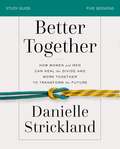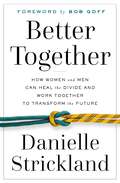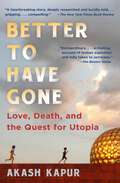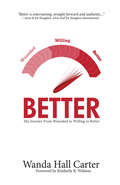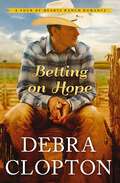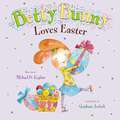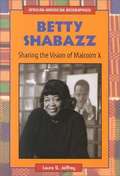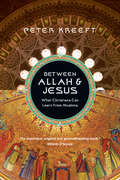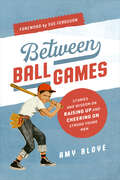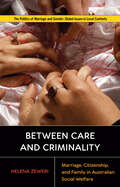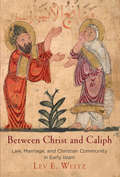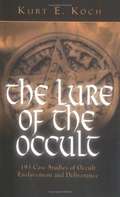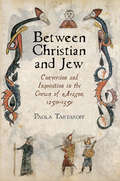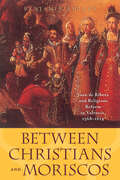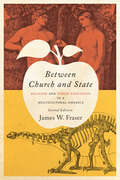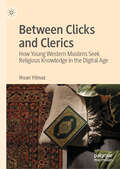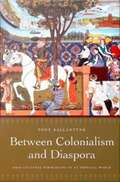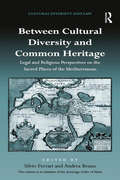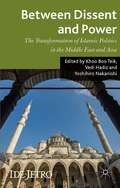- Table View
- List View
Better Together Bible Study Guide: How Women and Men Can Heal the Divide and Work Together to Transform the Future
by Danielle StricklandCan you imagine a future where women and men are better together?We are at a strategic cultural intersection where relationships between women and men are eroding. While it is good for women to expose their pain, abuse, and experiences of gender inequality and oppression, what often follows is a never-ending cycle of blame, accusations, denial, avoidance, and ultimately devastation for everyone involved.Better Together, a six-session video-based Bible study (DVD/digital downloads sold separately), is a beacon of hope in this challenging storm. Danielle Strickland helps us understand how oppression works–whether it relates to gender, race, socioeconomic status, or religion–and how to overcome it. Let Danielle inspire you to believe that change is possible and equip you with ideas and strategies that will compel you to action.The Better Together Study Guide includes six guided Group Gatherings intended to amplify the video teachings as well as between-session personal time to engage the Bible and study content.Sessions include:Through Kingdom LensesHope for the FuturePulling the ThreadEmbracing DifferenceReplacing Root BeliefsTransition to ThrivingDesigned for use with the Better Together Video Study (9780310110781), sold separately. Streaming video also available.
Better Together: Equality in Christ
by Kevin GilesIn 'Better Together', Kevin Giles positively considers from a Christian perspective the changes in the man-woman relationship that have occurred in recent years and invites us to take a fresh look at the biblical texts quoted in support of women's ongoing subordination, setting out questions at the end of each short chapter for home groups to discuss.
Better Together: How Women and Men Can Heal the Divide and Work Together to Transform the Future
by Danielle StricklandWe are currently at a strategic cultural intersection with relationships between women and men eroding. And it seems no one knows what to do. While it is good for women to expose their pain, what often happens is that they immediately blame the person at the other end of it, which sets up a never-ending cycle of accusations, denial, avoidance, and ultimately devastation for everyone involved.This moment of discovery should not signal the end but instead become an opportunity to create a different world where men and women are better together.Better Together is a beacon of hope in a challenging storm. It&’s where thoughts can be rechanneled and hope rekindled as author Danielle Strickland offers steps toward a real and workable solution. Her premise is that two things are needed for change:1) imagine a better world, and2) understand oppression.Understanding how oppression works is an important part of undoing it.Danielle says, &“I refuse to believe that all men are bad. I also refuse to believe that all women are victims. I don&’t want to be just hopeful, I want to be strategically hopeful. I want to work toward a better world with a shared view of the future that looks like equality, freedom, and flourishing.&”
Better to Have Gone: Love, Death, and the Quest for Utopia in Auroville
by Akash Kapur*Named a Best Book of the Year by The New York Times, Wall Street Journal, CNN, New Statesman, Air Mail, and more * Longlisted for the Chautauqua Prize * Recipient of a Whiting Grant*A &“haunting and elegant&” (The Wall Street Journal) story about love, faith, the search for utopia—and the often devastating cost of idealism.It&’s the late 1960s, and two lovers converge on an arid patch of earth in South India. John Walker is the handsome scion of a powerful East Coast American family. Diane Maes is a beautiful hippie from Belgium. They have come to build a new world—Auroville, an international utopian community for thousands of people. Their faith is strong, the future bright.So how do John and Diane end up dying two decades later, on the same day, on a cracked concrete floor in a thatch hut by a remote canyon? This is the mystery Akash Kapur sets out to solve in Better to Have Gone, and it carries deep personal resonance: Diane and John were the parents of Akash&’s wife, Auralice. Akash and Auralice grew up in Auroville; like the rest of their community, they never really understood those deaths.In 2004, Akash and Auralice return to Auroville from New York, where they have been living with John&’s family. As they reestablish themselves in the community, along with their two sons, they must confront the ghosts of those distant deaths. Slowly, they come to understand how the tragic individual fates of John and Diane intersected with the collective history of their town.&“A riveting account of human aspiration and folly taken to extremes&” (The Boston Globe), Better to Have Gone probes the underexplored yet universal idea of utopia and portrays in vivid detail the daily life of one such community. Richly atmospheric and filled with remarkable characters, spread across time and continents, this is narrative writing of the highest order—a &“gripping…compelling…[and] heartbreaking story, deeply researched and lucidly told&” (The New York Times Book Review).
Better: The Journey from Wounded to Willing to Better
by Wanda Hall CarterIn Better, Wanda Hall Carter speaks from experience and struggle, and coaches you to victory. Through strong biblical teaching, she takes you down a path to wholeness and freedom through small, incremental portals of daily self-assessment. Take up your cross. Lose your life so you can find it in Him. Be &“Better.&”
Betting on Hope: Betting On Hope, Counting On A Cowboy, And Kissed By A Cowboy (A Four of Hearts Ranch Romance #1)
by Debra CloptonOne clutzy advice columnist. One champion cowboy. And an entire small town rooting for love. Advice columnist Maggie Hope never dreamed she'd be shaking hands with champion horse trainer Tru Monahan over a high-stakes bet, especially one that involves horses. And saddles. And everything else a city girl like Maggie feels uncomfortable around. But after filling in for a coworker and interviewing the handsome cowboy, she finds herself doing just that. Anything to save her advice column. Despite Maggie's two left feet, Tru is bound and determined to bring out her inner cowgirl by teaching her to ride a cutting horse, trained to separate cattle from the rest of the herd. While her riding improves, their attraction intensifi es, but Tru knows he can never let her into his heart--for her own good. In Wishing Springs, a community full of meddling but well-meaning townsfolk, Maggie discovers the home she's always longed for. But she's holding something back--a secret that could destroy her reputation and any future she's ever hoped for with the cowboy she might just love.
Betting on Hope: Betting on Hope, Counting on a Cowboy, and Kissed by a Cowboy (A Four of Hearts Ranch Romance)
by Debra CloptonOne clutzy advice columnist. One champion cowboy. And an entire small town rooting for love. Advice columnist Maggie Hope never dreamed she'd be shaking hands with champion horse trainer Tru Monahan over a high-stakes bet, especially one that involves horses. And saddles. And everything else a city girl like Maggie feels uncomfortable around. But after filling in for a coworker and interviewing the handsome cowboy, she finds herself doing just that. Anything to save her advice column. Despite Maggie's two left feet, Tru is bound and determined to bring out her inner cowgirl by teaching her to ride a cutting horse, trained to separate cattle from the rest of the herd. While her riding improves, their attraction intensifi es, but Tru knows he can never let her into his heart--for her own good. In Wishing Springs, a community full of meddling but well-meaning townsfolk, Maggie discovers the home she's always longed for. But she's holding something back--a secret that could destroy her reputation and any future she's ever hoped for with the cowboy she might just love.
Betty Bunny Loves Easter (Betty Bunny)
by Michael KaplanNobunny does an Easter egg hunt quite like Betty Bunny! For fans of Ladybug Girl and Fancy Nancy, check out the loveable handful from the creator of Disney’s T.V. series Dog with a Blog.Yes, Betty Bunny loves Easter. She loves it so much that she just knows when she grows up, she will be the Easter Bunny. So it comes as quite a shock when she learns that her brothers and sister have been helping her in the egg hunt every year. Determined to find eggs on her own, this time, Betty Bunny also finds out a thing or two about the satisfaction of accomplishment. Going it alone, Betty Bunny strikes again in the latest in her series, a funny Easter tale of independence.
Betty Shabazz: Sharing the Vision of Malcolm X
by Laura S. JeffreyProfiles the life of Betty Shabazz, the widow of Malcolm X, discussing her life as the wife of the outspoken civil rights leader and her role in the civil rights movement after his death.
Betty: The International Bestseller
by Tiffany McDaniel'Breahtaking'Vogue'So engrossing! Betty is a page-turning Appalachian coming-of-age story steeped in Cherokee history, told in undulating prose that settles right into you'Naoise Dolan, Sunday Times bestselling author of Exciting Times 'I felt consumed by this book. I loved it, you will love it' Daisy Johnson, Booker Prize shortlisted author of Everthing Under'I loved Betty: I fell for its strong characters and was moved by the story it portrayed' Fiona Mozley, Booker Prize shortlisted author of Elmet 'A girl comes of age against the knife.' So begins the story of Betty Carpenter. Born in a bathtub in 1954 to a Cherokee father and white mother, Betty is the sixth of eight siblings. The world they inhabit is one of poverty and violence - both from outside the family and also, devastatingly, from within. When her family's darkest secrets are brought to light, Betty has no choice but to reckon with the brutal history hiding in the hills, as well as the heart-wrenching cruelties and incredible characters she encounters in her rural town of Breathed, Ohio.Despite the hardship she faces, Betty is resilient. Her curiosity about the natural world, her fierce love for her sisters and her father's brilliant stories are kindling for the fire of her own imagination, and in the face of all she bears witness to, Betty discovers an escape: she begins to write.A heartbreaking yet magical story, Betty is a punch-in-the-gut of a novel - full of the crushing cruelty of human nature and the redemptive power of words. 'Not a story you will soon forget' Karen Joy Fowler, Booker Prize shortlisted author of We Are All Completely Beside Ourselves 'Shot through with moonshine, Bible verses, and folklore, Betty is about the cruelty we inflict on one another, the beauty we still manage to find, and the stories we tell in order to survive' Eowyn Ivey, author of The Snow Child
Betty: The International Bestseller
by Tiffany McDaniel'NOT A STORY YOU WILL SOON FORGET' Karen Joy Fowler, author of Man Booker Prize finalist We Are All Completely Beside Ourselves'A girl comes of age against the knife.' So begins the story of Betty Carpenter. Born in a bathtub in 1954 to a Cherokee father and white mother, Betty is the sixth of eight siblings. The world they inhabit is one of poverty and violence - both from outside the family and also, devastatingly, from within. When her family's darkest secrets are brought to light, Betty has no choice but to reckon with the brutal history hiding in the hills, as well as the heart-wrenching cruelties and incredible characters she encounters in her rural town of Breathed, Ohio.Despite the hardship she faces, Betty is resilient. Her curiosity about the natural world, her fierce love for her sisters and her father's brilliant stories are kindling for the fire of her own imagination, and in the face of all she bears witness to, Betty discovers an escape: she begins to write.A heartbreaking yet magical story, Betty is a punch-in-the-gut of a novel - full of the crushing cruelty of human nature and the redemptive power of words.
Between Allah & Jesus: What Christians Can Learn from Muslims
by Peter KreeftWhat would happen if Christians and a Muslim at a university talked and disagreed, but really tried to understand each other? What would they learn? That is the intriguing question Peter Kreeft seeks to answer in these imaginative conversations at Boston College. An articulate and engaging Muslim student named 'Isa challenges the Christian students and professors he meets on issues ranging from prayer and worship to evolution and abortion, from war and politics to the nature of spiritual struggle and spiritual submission. While Kreeft believes Christians should not learn extremism or unitarian theology from Muslims, he does believe that if we really listened we could learn much about devoted religious practice and ethics. Here is a book to open your understanding of one of the key forces shaping our world today. It's a book that just could make you a better Christian.
Between Ball Games: Stories and Wisdom of Raising up and Cheering on Strong Young Men
by Amy BloyeFrom energy and injury to surviving middle school, moms are asking questions. They want to know about training, role models, overcoming fear, dealing with ADD, how to talk to their teenagers and how to get them to have a conversation. Moms want to know if they have permission to take care of themselves, how to not act shocked, and how to experience God’s grace and joy in being a boy mom. Twenty-six years of encouragement and wisdom is packed into this short read. Each three-to-five page chapter begins with a story and concludes with a challenging truth and a Scripture reference.
Between Care and Criminality: Marriage, Citizenship, and Family in Australian Social Welfare (Politics of Marriage and Gender: Global Issues in Local Contexts)
by Helena ZeweriBetween Care and Criminality examines social welfare’s encounter with migration and marriage in a period of intensified border control in Melbourne, Australia. It offers an in-depth ethnographic account of the effort to prevent forced marriage in the aftermath of a 2013 law that criminalized the practice. Disproportionately targeted toward Muslim migrant communities, prevention efforts were tasked with making the family relations and marital practices of migrants objects of policy knowledge in the name of care and community empowerment. Through tracing the everyday ways that direct service providers, police, and advocates learned to identify imminent marriages and at-risk individuals, this book reveals how the domain of social welfare becomes the new frontier where the settler colonial state judges good citizenship. In doing so, it invites social welfare to reflect on how migrant conceptions of familial care, personhood, and mutual obligation become structured by the violence of displacement, borders, and conditional citizenship.
Between Christ and Caliph: Law, Marriage, and Christian Community in Early Islam (Divinations: Rereading Late Ancient Religion)
by Lev E. WeitzIn the conventional historical narrative, the medieval Middle East was composed of autonomous religious traditions, each with distinct doctrines, rituals, and institutions. Outside the world of theology, however, and beyond the walls of the mosque or the church, the multireligious social order of the medieval Islamic empire was complex and dynamic. Peoples of different faiths—Sunnis, Shiites, Christians, Jews, and others—interacted with each other in city streets, marketplaces, and even shared households, all under the rule of the Islamic caliphate. Laypeople of different confessions marked their religious belonging through fluctuating, sometimes overlapping, social norms and practices.In Between Christ and Caliph, Lev E. Weitz examines the multiconfessional society of early Islam through the lens of shifting marital practices of Syriac Christian communities. In response to the growth of Islamic law and governance in the seventh through tenth centuries, Syriac Christian bishops created new laws to regulate marriage, inheritance, and family life. The bishops banned polygamy, required that Christian marriages be blessed by priests, and restricted marriage between cousins, seeking ultimately to distinguish Christian social patterns from those of Muslims and Jews. Through meticulous research into rarely consulted Syriac and Arabic sources, Weitz traces the ways in which Syriac Christians strove to identify themselves as a community apart while still maintaining a place in the Islamic social order. By binding household life to religious identity, Syriac Christians developed the social distinctions between religious communities that came to define the medieval Islamic Middle East. Ultimately, Between Christ and Caliph argues that interreligious negotiations such as these lie at the heart of the history of the medieval Islamic empire.
Between Christ and Satan
by Kurt E. KochWhat are the dangers of spiritism, magic, and occultism? What are the consequences if one trespasses into these areas? What does God say in His Word about these?
Between Christian and Jew
by Paola TartakoffIn 1341 in Aragon, a Jewish convert to Christianity was sentenced to death, only to be pulled from the burning stake and into a formal religious interrogation. His confession was as astonishing to his inquisitors as his brush with mortality is to us: the condemned man described a Jewish conspiracy to persuade recent converts to denounce their newfound Christian faith. His claims were corroborated by witnesses and became the catalyst for a series of trials that unfolded over the course of the next twenty months. Between Christian and Jew closely analyzes these events, which Paola Tartakoff considers paradigmatic of inquisitorial proceedings against Jews in the period. The trials also serve as the backbone of her nuanced consideration of Jewish conversion to Christianity--and the unwelcoming Christian response to Jewish conversions--during a period that is usually celebrated as a time of relative interfaith harmony.The book lays bare the intensity of the mutual hostility between Christians and Jews in medieval Spain. Tartakoff's research reveals that the majority of Jewish converts of the period turned to baptism in order to escape personal difficulties, such as poverty, conflict with other Jews, or unhappy marriages. They often met with a chilly reception from their new Christian brethren, making it difficult to integrate into Christian society. Tartakoff explores Jewish antagonism toward Christians and Christianity by examining the aims and techniques of Jews who sought to re-Judaize apostates as well as the Jewish responses to inquisitorial prosecution during an actual investigation. Prosecutions such as the 1341 trial were understood by papal inquisitors to be in defense of Christianity against perceived Jewish attacks, although Tartakoff shows that Christian fears about Jewish hostility were often exaggerated. Drawing together the accounts of Jews, Jewish converts, and inquisitors, this cultural history offers a broad study of interfaith relations in medieval Iberia.
Between Christians and Moriscos: Juan de Ribera and Religious Reform in Valencia, 1568–1614 (The Johns Hopkins University Studies in Historical and Political Science #124)
by Benjamin EhlersIn early modern Spain the monarchy's universal policy to convert all of its subjects to Christianity did not end distinctions among ethnic religious groups, but rather made relations between them more contentious. Old Christians, those whose families had always been Christian, defined themselves in opposition to forcibly baptized Muslims (moriscos) and Jews (conversos). Here historian Benjamin Ehlers studies the relations between Christians and moriscos in Valencia by analyzing the ideas and policies of archbishop Juan de Ribera. Juan de Ribera, a young reformer appointed to the diocese of Valencia in 1568, arrived at his new post to find a congregation deeply divided between Christians and moriscos. He gradually overcame the distrust of his Christian parishioners by intertwining Tridentine themes such as the Eucharist with local devotions and holy figures. Over time Ribera came to identify closely with the interests of his Christian flock, and his hagiographers subsequently celebrated him as a Valencian saint. Ribera did not engage in a similarly reciprocal exchange with the moriscos; after failing to effect their true conversion through preaching and parish reform, he devised a covert campaign to persuade the king to banish them. His portrayal of the moriscos as traitors and heretics ultimately justified the Expulsion of 1609–1614, which Ribera considered the triumphant culmination of the Reconquest. Ehler's sophisticated yet accessible study of the pluralist diocese of Valencia is a valuable contribution to the study of Catholic reform, moriscos, Christian-Muslim relations in early modern Spain, and early modern Europe.
Between Christians and Moriscos: Juan de Ribera and Religious Reform in Valencia, 1568–1614 (The Johns Hopkins University Studies in Historical and Political Science #124)
by Benjamin EhlersThis “excellent study” shows how a Spanish archbishop laid the groundwork for the seventeenth-century expulsion of the Moriscos (James B. Tueller, Renaissance Quarterly).In early modern Spain, the monarchy’s policy of converting all subjects to Christianity only created new forms of tension among ethnic religious groups. Those whose families had always been Christian defined themselves in opposition to forcibly baptized Muslims (moriscos) and Jews (conversos). Here historian Benjamin Ehlers studies the relations between Christians and moriscos in Valencia by analyzing the ideas and policies of archbishop Juan de Ribera.Appointed to the diocese of Valencia in 1568, Juan de Ribera encountered a congregation deeply divided between Christians and moriscos. He came to identify with his Christian flock, leading hagiographers to celebrate him as a Valencian saint. But Ribera had a very different relationship with the moriscos, eventually devising a covert campaign to have them banished. His portrayal of the moriscos as traitors and heretics ultimately justified the Expulsion of 1609–1614, which Ribera considered the triumphant culmination of the Reconquest.Ehler’s sophisticated yet accessible study of the pluralist diocese of Valencia is a valuable contribution to the study of Catholic reform, moriscos, Christian-Muslim relations in early modern Spain, and early modern Europe.
Between Church and State: Religion and Public Education in a Multicultural America
by James W. FraserA fully updated second edition of this essential look at the continuing tensions between religion and American public schools.Today, the ongoing controversy about the place—or lack of place—of religion in public schools is a burning issue in the United States. Prayer at football games, creationism in the classroom, the teaching of religion and morals, and public funding for private religious schools are just a few of the subjects over which people are skirmishing. In Between Church and State, historian and pastor James W. Fraser shows that these battles have been going on for as long as there have been public schools and argues there has never been any consensus about what the "separation of church and state" means for American society or about the proper relationship between religion and public education.Looking at the difficult question of how private issues of faith can be reconciled with the very public nature of schooling, Fraser’s classic book paints a complex picture of how a multicultural society struggles to take the deep commitments of people of faith into account—including people of many different faiths and no faith. In this fully updated second edition, Fraser tackles the culture wars, adding fresh material on current battles over public funding for private religious schools. He also addresses the development of the long-simmering evolution-creationism debate and explores the tensions surrounding a discussion of religion and the accommodation of an increasingly religiously diverse American student body.Between Church and State includes new scholarship on the role of Roger Williams and William Penn in developing early American conceptions of religious liberty. It traces the modern expansion of Catholic parochial schools and closely examines the passage of the First Amendment, changes in American Indian tribal education, the place of religion in Booker T. Washington and W. E. B. Du Bois’s debates about African American schooling, and the rapid growth of Jewish day schools among a community previously known for its deep commitment to secular public education.
Between Clicks and Clerics: How Young Western Muslims Seek Religious Knowledge in the Digital Age
by Ihsan YilmazThis book explores the lived experiences of young Muslims in Australia, the United Kingdom, and the United States as they seek religious guidance in an increasingly digital world. Based on extensive qualitative research—including interviews with 122 young Muslims—it examines how faith, identity, and knowledge come together in modern society. In doing so, the book looks at the role of imams in diaspora communities, the trust (or skepticism) placed in online religious sources, and the influence of family, friends, and digital religious figures. Between Clicks and Clerics captures the shifts in religious learning as young Muslims turn to both traditional and digital sources. Through firsthand narratives, this book highlights the voices of young Muslims as they work through questions of authenticity, authority, and independence in their spiritual journeys. It shows how they balance tradition with modern life, skepticism with belief, and personal choice with community expectations. As religious authority spreads beyond traditional figures, this book examines how Islamic knowledge is changing in the Anglosphere and what it means for the future.
Between Colonialism and Diaspora: Sikh Cultural Formations in an Imperial World
by Tony BallantyneTony Ballantyne is Senior Lecturer in History at the University of Otago in New Zealand. He is the author of Orientalism and Race: Aryanism in the British Empire and a coeditor of Bodies in Contact: Rethinking Colonial Encounters in World History, also published by Duke University Press.
Between Cultural Diversity and Common Heritage: Legal and Religious Perspectives on the Sacred Places of the Mediterranean (Cultural Diversity and Law)
by Silvio FerrariGoing beyond the more usual focus on Jerusalem as a sacred place, this book presents legal perspectives on the most important sacred places of the Mediterranean. The first part of the book discusses the notion of sacred places in anthropological, sociological and legal studies and provides an overview of existing legal approaches to the protection of sacred places in order to develop and define a new legal framework. The second part introduces the meaning of sacred places in Jewish, Christian and Islamic thought and focuses on the significance and role that sacred places have in the three major monotheistic religions and how best to preserve their religious nature whilst designing a new international statute. The final part of the book is a detailed analysis of the legal status of key sacred places and holy cities in the Mediterranean area and identifies a set of legal principles to support a general framework within which specific legal measures can be implemented. The book concludes with a useful appendix for the protection of sacred places in the Mediterranean region. Including contributions from leading law and religion scholars, this interesting book will be valuable to those in the fields of international law, as well as religion and heritage studies.
Between Dignity and Despair: Jewish Life in Nazi Germany
by Marion A. KaplanBetween Dignity and Despair draws on the extraordinary memoirs, diaries, interviews, and letters of Jewish women and men to give us the first intimate portrait of Jewish life in Nazi Germany. Kaplan tells the story of Jews in Germany not from the hindsight of the Holocaust, nor by focusing on the persecutors, but from the bewildered and ambiguous perspective of Jews trying to navigate their daily lives in a world that was becoming more and more insane. Answering the charge that Jews should have left earlier, Kaplan shows that far from seeming inevitable, the Holocaust was impossible to foresee precisely because Nazi repression occurred in irregular and unpredictable steps until the massive violence of November 1938. Then the flow of emigration turned into a torrent, only to be stopped by the war. By that time Jews had been evicted from their homes, robbed of their possessions and their livelihoods, shunned by their former friends, persecuted by their neighbors, and driven into forced labor. For those trapped in Germany, mere survival became a nightmare of increasingly desperate options. Many took their own lives to retain at least some dignity in death; others went underground and endured the fears of nightly bombings and the even greater terror of being discovered by the Nazis. Most were murdered. All were pressed to the limit of human endurance and human loneliness. Focusing on the fate of families and particularly women's experience, Between Dignity and Despair takes us into the neighborhoods, into the kitchens, shops, and schools, to give us the shape and texture, the very feel of what it was like to be a Jew in Nazi Germany.
Between Dissent and Power
by Vedi R. Hadiz Khoo Boo Teik Yoshihiro NakanishiThis study examines the collective progression of Islamic politics between points of dissent and positions of power. It brings about a more a serious understanding of Islamic politics by critically tracing the pathways by which Islamic politics has been transformed in the Middle East and Asia.
